Introduction
In the realm of data visualization, Power BI stands out as a powerful tool that transforms raw data into actionable insights. As organizations strive to enhance their reporting capabilities, understanding the nuances of data labels becomes paramount. These labels not only convey essential metrics but also facilitate a clearer interpretation of trends and patterns, making them indispensable for effective decision-making.
By mastering the art of customizing data labels, professionals can significantly elevate the clarity and impact of their visualizations. This article delves into practical strategies for optimizing data labels, from establishing a robust data model to employing advanced techniques that enhance user engagement.
As businesses navigate the complexities of data management, these insights will empower them to harness the full potential of Power BI, driving efficiency and fostering informed choices.
Understanding Data Labels in Power BI: An Overview
In Power BI, the use of data label power bi serves as essential instruments for efficiently communicating insights within visual representations, allowing viewers to quickly grasp important metrics. These tags show values associated with particular data points, simplifying the analysis of trends and patterns. As Mitchell Pearson, an experienced Data Platform Consultant and Training Manager at Pragmatic Works, points out, ‘A key aspect is creating a DAX calculation named ‘custom identifier’, which allows for the display of desired information.’
Customizing data labels in Power BI can substantially enhance the clarity and effect of your documents, ensuring that your audience receives critical insights at a glance. In addressing common challenges such as time-consuming report creation and inconsistencies, effective data label power bi strategies become essential. The absence of a governance strategy can result in confusion and mistrust in the information presented, making the implementation of clear data label power bi practices even more important.
To create impactful dashboards, consider:
- Showing all important information on a single screen for quick access to essential details.
- Utilizing tools like Microsoft Copilot and predictive analytics to enhance your reporting capabilities.
The column statistics chart shown below the preview section can further enhance understanding.
By concentrating on personalized information tags, as emphasized in numerous case studies, you can greatly enhance the clarity of your visual representations, aiding improved decision-making processes and ultimately fostering growth through insight-driven analysis.
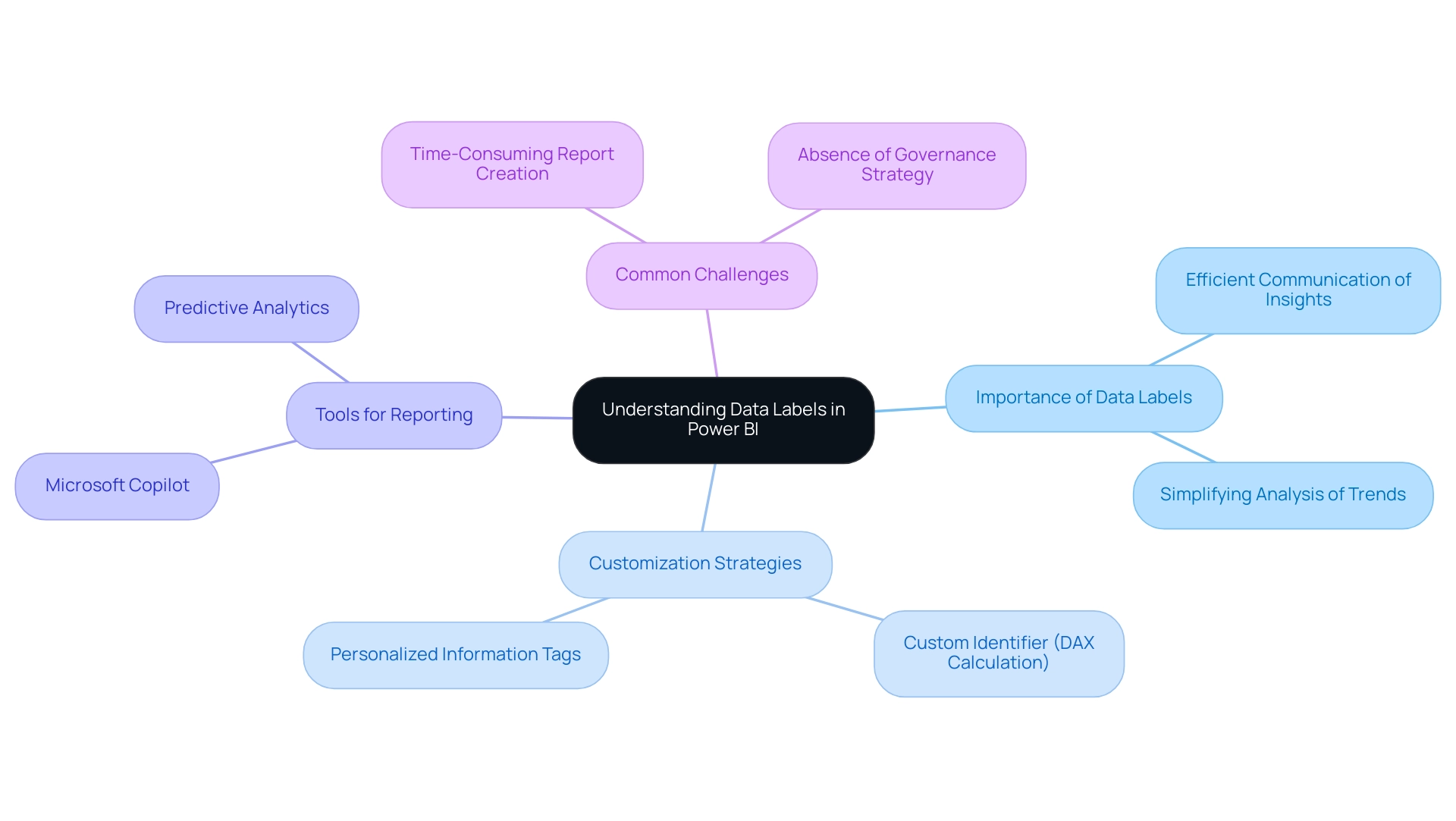
Essential Preparations for Customizing Data Labels
To effectively personalize data label Power BI, it is essential to create a dedicated calendar table within your information model. This essential component serves as the backbone for time-based analysis, facilitating the creation of measures that significantly improve your data label Power BI. Denys Velykozhon highlights the significance of such structures in his discussions on reporting, stressing that a solid foundation is key to effective information interpretation.
Furthermore, leveraging Business Intelligence tools like EMMA RPA and Power Automate can streamline this process, transforming raw information into actionable insights that drive efficiency and growth. Additionally, while Power BI offers the Auto date/time option for simple model requirements and ad hoc information exploration, it does not support a single date table design for multiple tables, making the use of a dedicated calendar table with data label Power BI a better choice for complex models. This choice can alleviate common challenges such as inconsistencies and time-consuming report creation, enabling a more efficient workflow.
Moreover, when a model already has a date table and another is needed for a role-playing dimension, a calculated table can be created to clone the existing date table using DAX. However, it’s essential to note that the cloned table only creates columns without applying model properties like formats or descriptions, and hierarchies are not cloned. Presenting the earliest date in the model as Min Date and the latest date as Max Date further emphasizes the significance of implementing a calendar table for effective information modeling, especially in relation to the data label Power BI.
Getting accustomed to the visualizations you plan to utilize is also essential, as each may provide unique options for showcasing labels. Comprehending the interplay between your information structure and visualization types will empower you to establish an effective groundwork for your customization efforts, ultimately driving insightful analysis and informed decision-making. By utilizing RPA tools, organizations can automate repetitive reporting tasks, enabling teams to concentrate on deriving insights instead of getting bogged down in preparation.
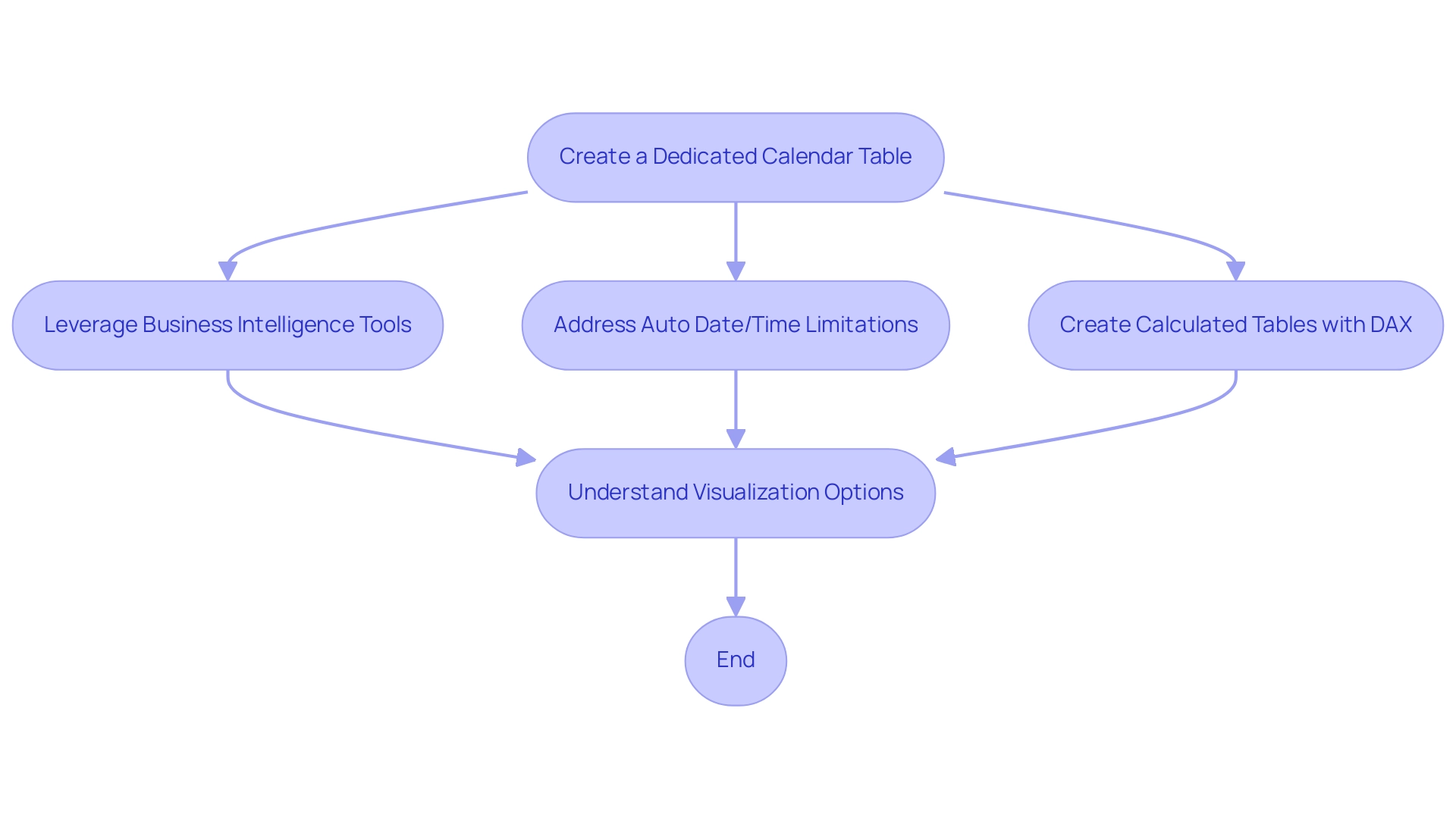
Creating Measures for Enhanced Data Labeling
Developing metrics for improved data label power bi is a simple yet impactful procedure that can greatly enhance your reporting abilities and boost operational efficiency. Begin by navigating to the ‘Modeling’ tab in Power BI Desktop and selecting ‘New Measure.’ Here, you’ll harness the power of DAX (Data Analysis Expressions) to define the metrics you wish to display.
For example, to illustrate total sales for a specific category, your DAX formula would be structured as follows: Total Sales = SUM(Sales[Amount]). Upon creation, these measures effortlessly merge into your labels, enabling dynamic updates that react to user interactions with the document. This method not only improves the clarity of your visuals but also enables stakeholders to extract insights swiftly and efficiently, tackling common issues such as time-consuming document creation and inconsistencies in information.
Furthermore, it is essential to provide actionable guidance within these reports to ensure stakeholders understand the next steps they should take based on the information presented. As mentioned by Super User Amit Chandak at the Microsoft Analytics Community Conference:
Join us as experts from around the world unite to shape the future of information and AI! This event highlights the increasing importance of information management and visualization in the industry.
Furthermore, it’s essential to keep pertinent dashboards, as displays not shown likely haven’t been utilized in over 90 days. The ability to leverage DAX for enhanced data label power bi, especially in visualizations like column charts, highlights the importance of interpreting information effectively. For instance, displaying mean, median, mode, and standard deviation together can highlight outliers, presenting a well-rounded view of your dataset, which aligns with the practical steps outlined in our guide.
Additionally, incorporating RPA solutions can further streamline reporting processes, reducing the time spent on report creation and enhancing overall operational efficiency.
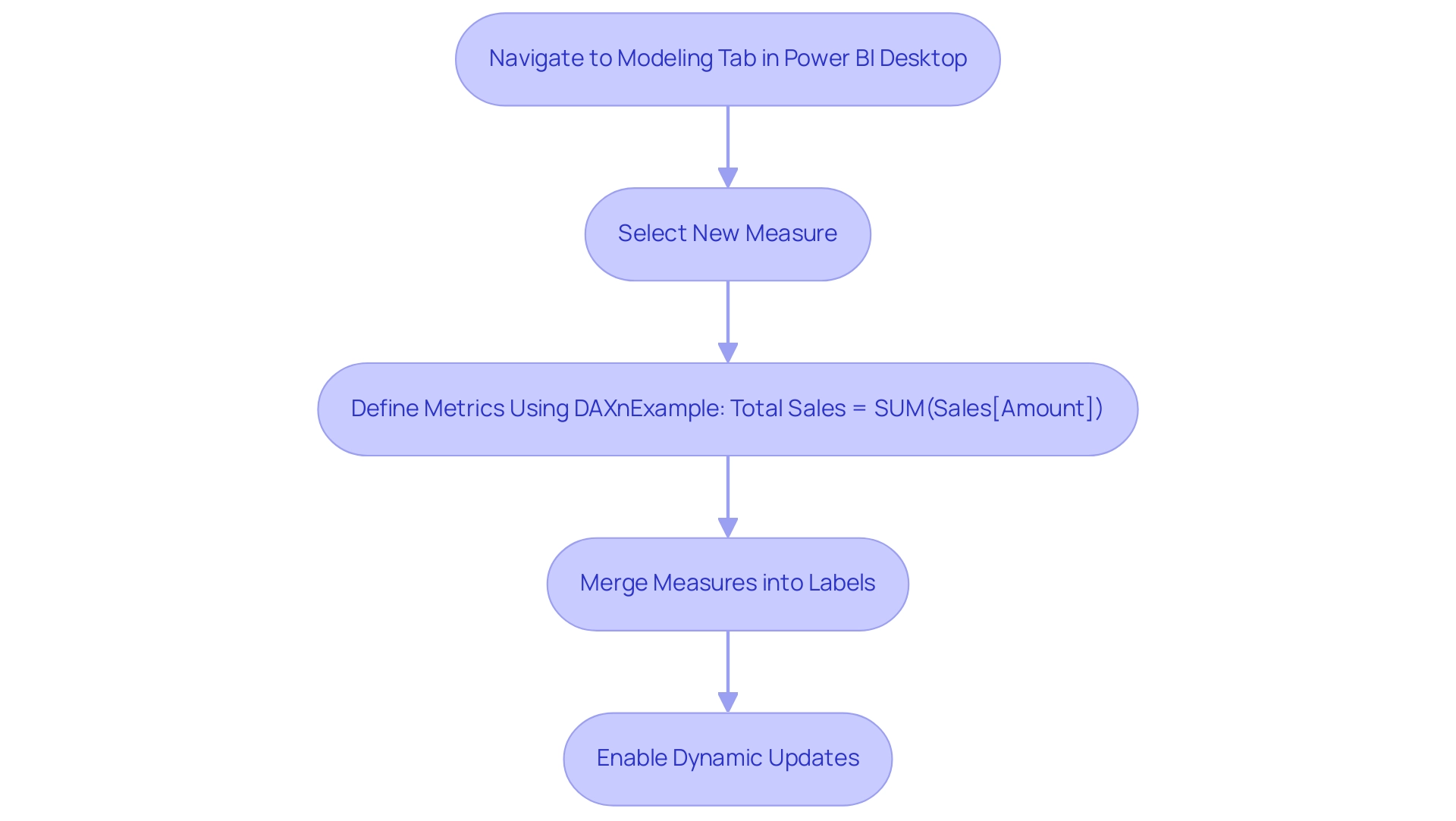
Formatting Visuals for Effective Data Label Presentation
To achieve effective data presentation in Power BI, start by selecting the visual you want to customize and then use the data label Power BI feature in the ‘Format’ pane. Here, you can modify essential settings such as font size, color, and position of the text. Increasing the font size can significantly enhance visibility, while choosing colors that contrast with the background ensures that text stands out.
According to Vinay Koshy, founder of Sproutworth,
Articles containing relevant images get 94% more total views compared to those without visuals, underscoring the importance of visual elements in communication. Additionally, 65% of companies indicate heightened client engagement and comprehension when employing visual representation in their presentations. Notably, infographics and visual content are shared and liked three times more than any other type of content on social media, highlighting their effectiveness in engagement.
Additionally, a case study on video marketing reveals that 85% of businesses consider it an effective tool for enhancing brand recall and increasing purchase intent, further emphasizing the impact of visual tools in communication. By integrating insights from Business Intelligence and leveraging RPA to automate repetitive reporting tasks, you can streamline your workflow, reduce errors, and free up your team for more strategic decisions. Thus, try out these formatting choices to achieve a balance between appearance and clarity; this will guarantee your data label Power BI effectively communicates the intended insights.
By following best practices for enhancing visibility, such as consistent formatting and strategic placement, you can maximize the impact of your presentations while overcoming challenges like inconsistencies and time-consuming report creation. Current trends in visual customization indicate that tailored visuals not only improve comprehension but also foster engagement, as design experts suggest that integrating dynamic elements can significantly enhance the viewer’s experience. Additionally, utilizing RPA can address task repetition fatigue, thereby improving operational efficiency and allowing your team to focus on high-value activities.
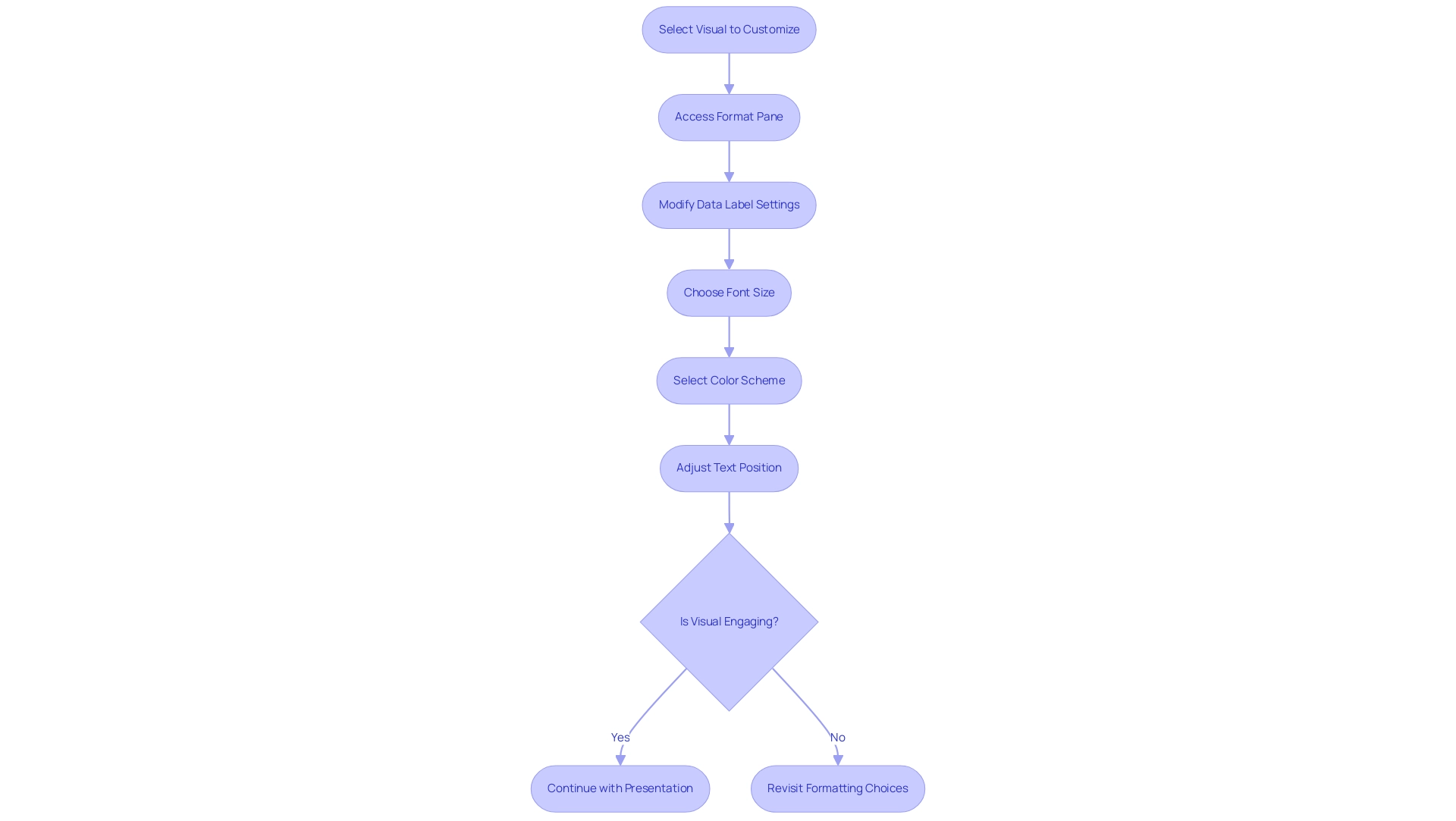
Advanced Techniques for Dynamic Data Label Customization
To leverage advanced techniques for dynamic information customization in Power BI, utilizing DAX expressions is essential for establishing conditional formatting rules. By applying these guidelines, you can modify information tags to alter hues according to particular value limits, greatly enhancing visual indicators and boosting understanding. This transformation is key in a data-rich environment where extracting meaningful insights is crucial for maintaining a competitive advantage, especially in light of the common challenges many organizations face in this area.
Additionally, integrating RPA solutions can streamline processes and enhance operational efficiency, further supporting the goal of utilizing Business Intelligence to drive growth and innovation. Incorporating tooltips can offer additional context, enhancing the story communicated by your information tags. This approach not only elevates the interactivity of your reports but also aligns with the broader goal of utilizing Business Intelligence to drive growth and innovation.
As you refine these techniques, consider how user interactions with data label power bi can elevate the overall effectiveness of your reporting strategy. For those looking to deepen their understanding, weekend training sessions are available on August 13, 14, 18, 19, 20, 21, 22, 25, 26, and 28, 2025. As Amitabh Saxena aptly states, ‘Enroll Now’ to take advantage of these learning opportunities.
Furthermore, the case study titled ‘Understanding Complex Formulas in Power BI’ highlights the challenges users face when dealing with complex formulas, particularly in calculating totals, emphasizing the need for advanced logic essential for high-quality development in Power BI, such as the implementation of data label power bi.
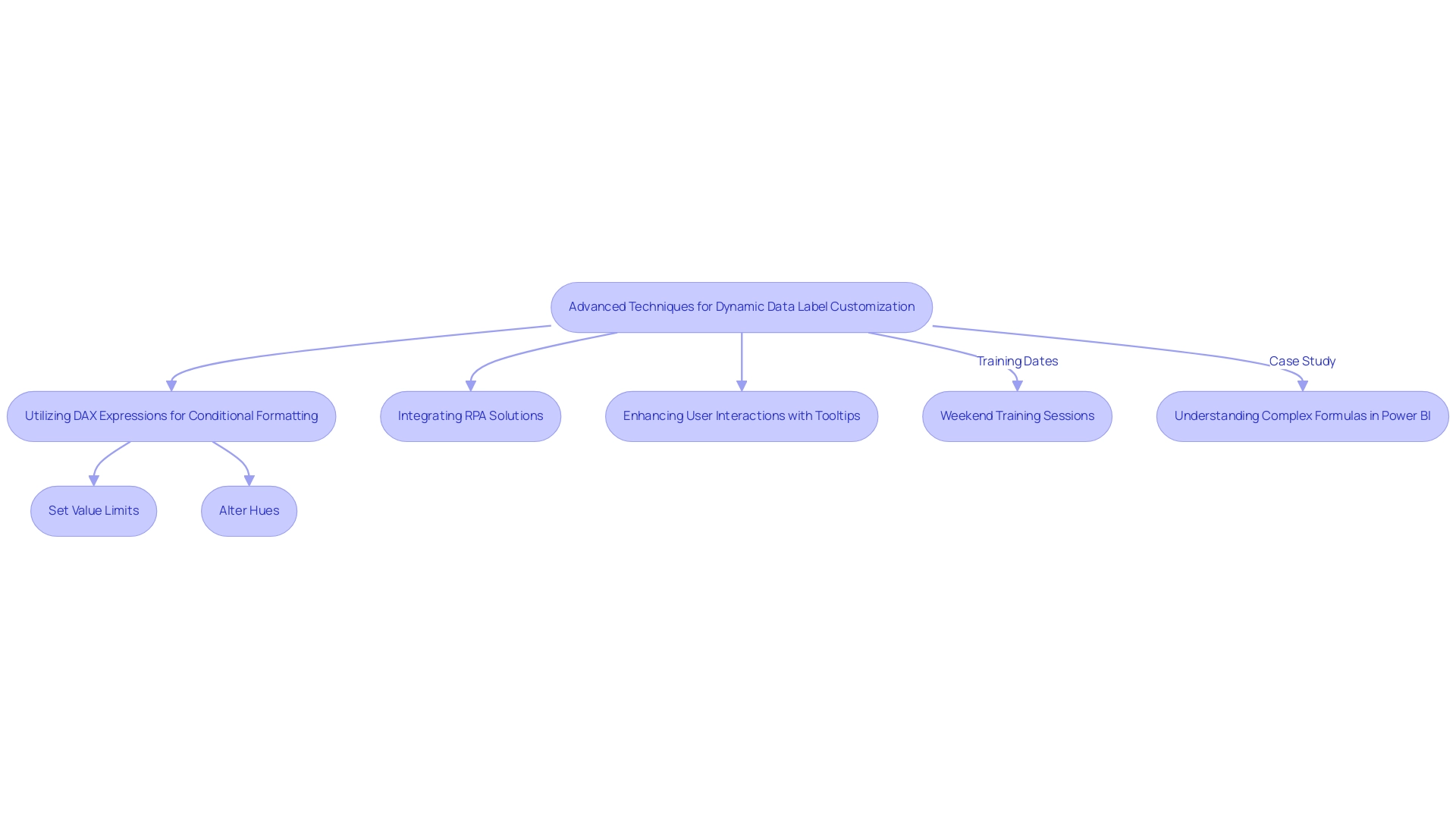
Conclusion
Customizing data labels in Power BI is not just a technical necessity; it is a strategic advantage that can transform how organizations interpret and act on their data. By effectively utilizing data labels, professionals can convey critical insights, making complex datasets accessible and actionable for stakeholders. Establishing a solid data model, particularly through the creation of a dedicated calendar table, serves as a foundation for enhanced data analysis and reporting.
Moreover, the integration of DAX measures allows for dynamic updates that enrich data labels, ensuring clarity and relevance in every report. The importance of formatting visuals cannot be overstated, as thoughtful adjustments can significantly improve readability and engagement. Utilizing advanced techniques, such as conditional formatting and tooltips, further elevates the impact of data labels, making them not only informative but also visually engaging.
In a landscape where data-driven decision-making is paramount, mastering these labeling strategies in Power BI empowers organizations to navigate complexities with confidence. By prioritizing clear and customized data labels, businesses can not only enhance their reporting capabilities but also foster a culture of informed decision-making that drives growth and operational efficiency. Embracing these practices is essential for staying competitive and maximizing the potential of data insights.

